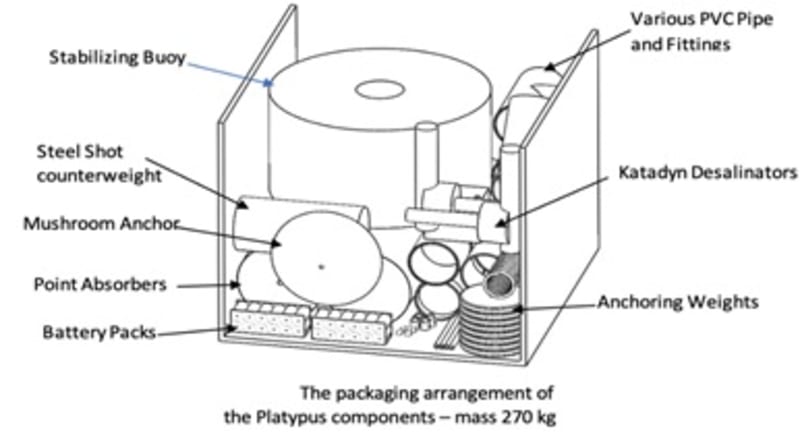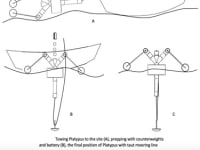The Platypus is the first small-scale, low-cost Wave Energy Converter (WEC) designed for coastal emergencies and the desalination of water. The state-of-the-art machine converts ocean wave energy into electricity. The movements of surface seawater put Platypus to work as a dependable generator of electrical power. Wave energy is 5 to 10 times more “energetic” than other forms of renewable energies. The Platypus can power desalinators, operate scientific equipment, lighting, heating, radios, phones and other electrical devices. An up-scaled version of the Platypus could provide power to rural ocean-front communities.
This simple device, currently made from off-the-shelf components, is an invaluable tool for emergency relief teams, scientists and military personnel. A much larger version of the Platypus can be useful for boaters, ships at sea, offshore drilling rigs and for powering small ocean-front communities in remote parts of the world. Powering equipment in emergency situations requires generators that operate on gasoline which can be hazardous to airdrop or unavailable after destructive storms, tsunamis or other disasters.
The manufacturing cost of the Platypus is $1500 to be competitive with diesel technology. Sales of the Platypus are expected to exceed $1.6 million by 2024 in the United States and over a 24 million dollars worldwide.
The Platypus offers many features to supplement FEMA’s options for emergency power during coastal disasters, and many excellent features for the military, researchers, businesses and ocean front communities:
- 100 Watts of Power and Scalable to 1000 Watts and Higher
- Lightweight at 125 Pounds and Deployable in Under an Hour
- Can Be Used to Operate Emergency Relief Equipment
- Can Be Customized for Military Operations or Emergency Power at Sea
- Can Be Used as a Charging Station for Future Electric Boats
The Platypus produces power from the up and down motion of ocean waves that swing arms and rotate generators to produce electricity that can be sent to shore or stored in batteries. In near shore deployment of the Platypus (under 500 feet), an underwater marine electrical cable is rolled to the beach to power equipment. In deep sea situations, the removable battery packs can be retrieved, or charging ports are available right at the Platypus. The Platypus is the first salable WEC that can fit within a standard four-foot shipping container and deployed in under one hour.
Unlike other WEC designs, the Platypus houses electrical components, gear trains and generators above the ocean’s surface thus the reliability and longevity of the system is greatly improved. To capture the energy efficiently, the Platypus is tuned to a wave height of 1 meter which occurs 28% of the time according to ocean research data. To accommodate other ocean conditions, the machine can be easily retuned by adjusting the arm length of the point absorbers. Since the body of the Platypus is made from PVC plastic pipe, aluminum and other off the shelf components, the machine is inexpensive to manufacture yet very durable in the harsh ocean environment. Thanks for your interest, and see you at sea!
Video
Like this entry?
-
About the Entrant
- Name:Mark Supal
- Type of entry:teamTeam members:Mark Supal
Robert Pauley - Software used for this entry:Solidworks and MatLab Simulink
- Patent status:pending








